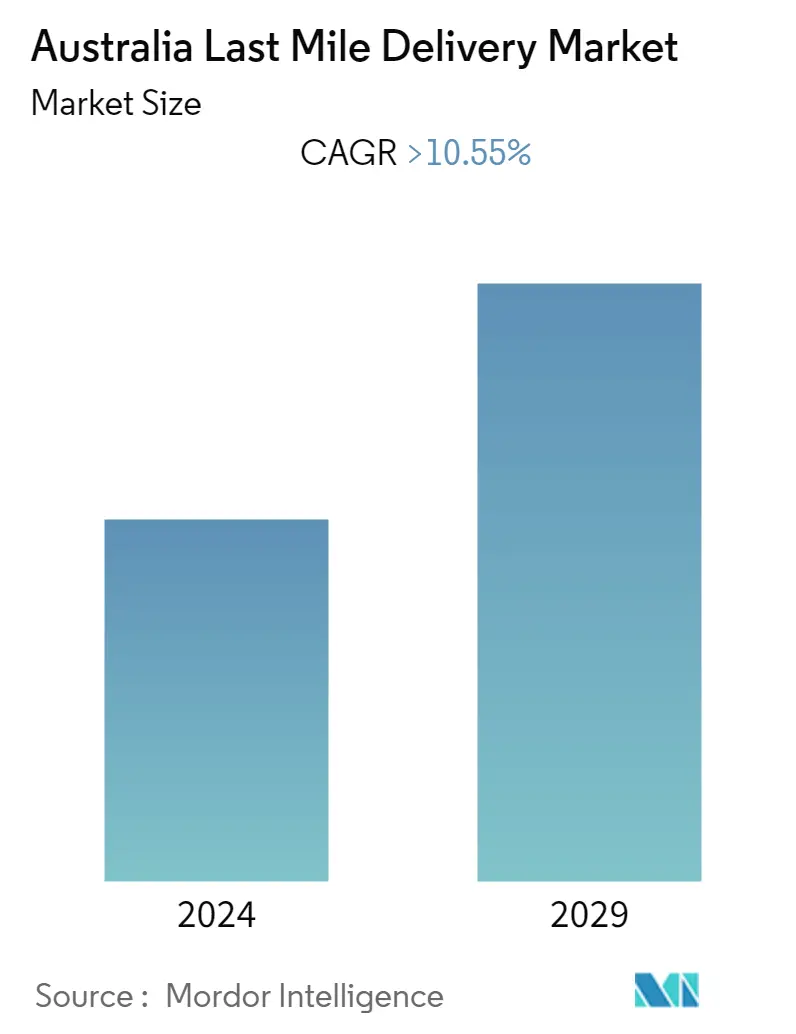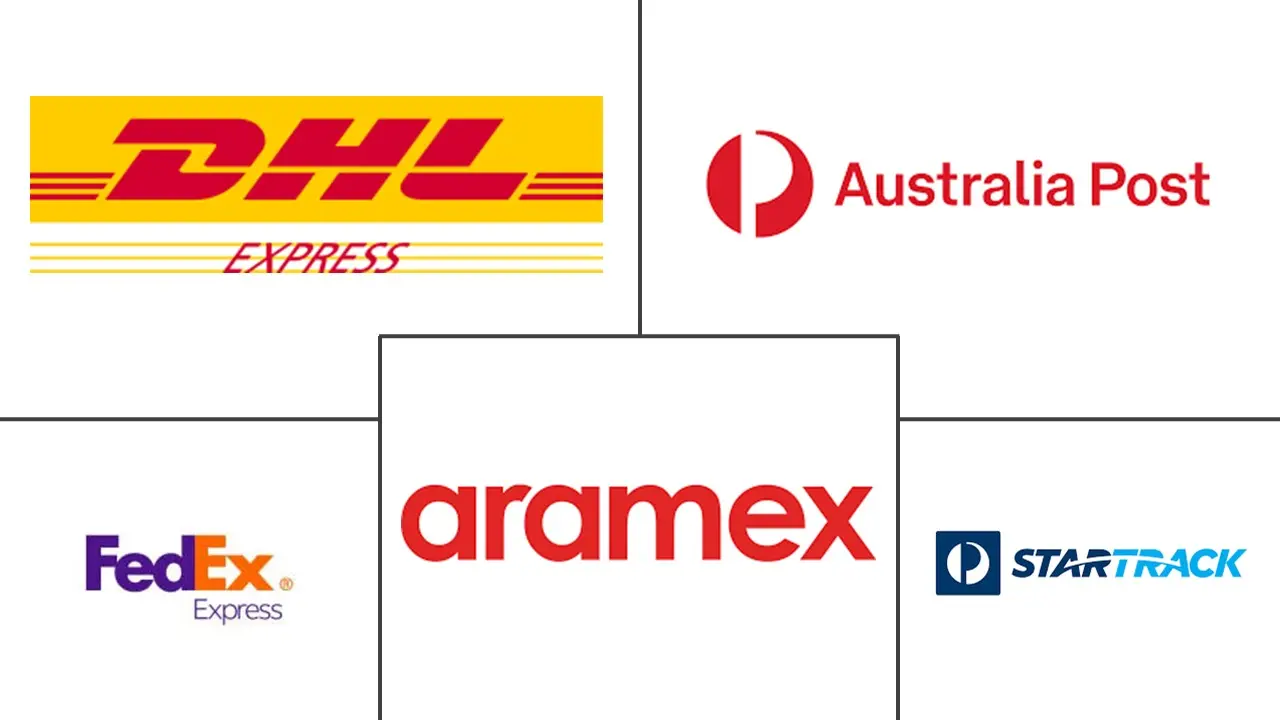Market Size of Australia Last Mile Delivery Industry

| Study Period | 2020 - 2029 |
| Base Year For Estimation | 2023 |
| Forecast Data Period | 2024 - 2029 |
| Historical Data Period | 2020 - 2022 |
| CAGR | > 10.55 % |
| Market Concentration | Medium |
Major Players
*Disclaimer: Major Players sorted in no particular order |
Australia Last Mile Delivery Market Analysis
The Australia last mile delivery market is expected to record a CAGR of more than 10.55% during the forecast period, 2022-2027.
The COVID-19 pandemic caused worldwide lockdowns, disrupted commercial activities and challenged the economy but created widespread opportunities for the last mile delivery market in Australia. There was a shift in consumer buying behaviour causing a surge in e-commerce retail sales fueling the powerful opportunity for logistics industrialists to push through real and lasting change. COVID-19 triggered exponential growth in e-commerce and spurred many smaller retailers to utilize the supply chain mechanism to deliver their products directly to consumers. According to the Australian Bureau of Statistics, online sales in Australia registered a 55% rise in December 2020 compared to the same period last year. Australia Post's Online Shopping Report published in January 2021 reveals that over 5.6 million Australian households shopped online in December 2020, a 21.3% growth compared to the 2019 average. A 2020 global study showed on average 22% of people shopped online weekly, up from 17% in 2019, Australia exceeded the global average with 26.5% giving surplus opportunities to logistics sector.
The online retailing boom has driven logistics occupiers in Australia to consider different ways to manage last mile logistics requirements in the country. Amid E-commerce growth rates, the last mile has become a critical aspect of the supply chain. Demand for 'last mile' is led by grocery giants like Coles and Woolworths. Coles reported 48% growth in e-commerce sales in their 2021 half yearly result, generating USD 1.0 billion in sales revenue. Similarly, Woolworths reported USD 1.8 billion in e-commerce sales and 91.8% growth rate over H1 2020. Woolworths also accounted that average weekly traffic to digital assets increased 62.4% to 20.2 million visits per week, as customers increasingly looked to engage digitally as part of their shopping experience.
Consumer demand for omnichannel offerings has accelerated as Australia continues to close the gap on leading e-commerce countries. Gaining market share will require a customer-centric and economically sustainable supply chain. Companies such as Australian based, DriveYello, Zoom2U, Sendle and Sherpa are stepping in to fulfil 'the last mile' requests. These companies allow private drivers/cyclists to become couriers and thus have an incredible network to make point-to-point deliveries. And with an easy to use interface, an offer of USD 11 same day delivery (and 3 hours in metropolitan regions), these start-up couriers are disrupting 'the last mile' market for the benefit of online retailers. Uber is also venturing into the space with UberRUSH - effectively utitlising their network of Uber drivers to act as couriers for retailers. The ongoing evolution of the supply-chain will continue to drive the pursuit of 'last mile' logistics solutions.
Australia Last Mile Delivery Industry Segmentation
Last mile delivery refers to the last leg of logistics operations. A product's journey from a warehouse to the doorstep of the end customer. This last step of the delivery process is most critical and should be well managed for the speedy shipping. A complete background analysis of Australia's last mile delivery market, including the assessment of the economy and contribution of sectors in the economy, market overview, market size estimation for key segments, and emerging trends in the market segments, market dynamics, and geographical trends, is included in the report.
The Last Mile Delivery Market is segmented By Type (B2B, B2C, C2C), By Delivery Mode (Regular Delivery, Same-day Delivery, Express Delivery). The report offers market size and forecasts in values (USD billion) for all the above segments.
| By Type | |
| B2B | |
| B2C | |
| C2C |
| By Delivery Mode | |
| Regular Delivery | |
| Same-day Delivery | |
| Express Delivery |
Australia Last Mile Delivery Market Size Summary
The Australia last mile delivery market is experiencing significant growth, driven by the surge in e-commerce and changing consumer behaviors, particularly accelerated by the COVID-19 pandemic. The shift towards online shopping has created substantial opportunities for logistics companies to innovate and adapt their supply chain strategies. This transformation has been particularly evident in the grocery sector, with major retailers like Coles and Woolworths reporting substantial increases in e-commerce sales. The demand for efficient last mile delivery solutions has prompted the emergence of new players and technologies, including startups that leverage digital platforms to enhance delivery services. These developments are reshaping the competitive landscape, with traditional logistics providers and new entrants vying for market share in a rapidly evolving environment.
The market is characterized by a high level of competition and consolidation, with major international carriers such as Australia Post, DHL Express, and FedEx Express Australia dominating the scene. However, the influx of startups and the trend of mergers and acquisitions are fostering a dynamic market atmosphere. Companies are increasingly investing in digital initiatives and forming strategic alliances to enhance their delivery capabilities and expand their networks. The Australian government's investment in digital infrastructure and international agreements, such as the Singapore-Australia Digital Economy Agreement, further supports the growth of the last mile delivery sector. As the market continues to evolve, the focus on customer-centric and sustainable supply chain solutions remains paramount for companies aiming to capture a larger share of the burgeoning e-commerce market.
Australia Last Mile Delivery Market Size - Table of Contents
-
1. MARKET INSIGHTS DYNAMICS
-
1.1 Current Market Scenario
-
1.2 Market Overview
-
1.3 Market Dynamics
-
1.3.1 Drivers
-
1.3.2 Restraints
-
1.3.3 Opportunities
-
-
1.4 Value Chain / Supply Chain Analysis
-
1.5 Porter's Five Forces Analysis
-
1.5.1 Threat of New Entrants
-
1.5.2 Bargaining Power of Buyers/Consumers
-
1.5.3 Bargaining Power of Suppliers
-
1.5.4 Threat of Substitute Products
-
1.5.5 Intensity of Competitive Rivalry
-
-
1.6 Technological Trends and Automation in Last Mile Delivery
-
1.7 Government Regulations and Initiatives
-
1.8 Insights into Industry Value Chain
-
1.9 Insights into E-commerce industry in Australia
-
1.10 Insights into Cross-border trade of Australia with other countries
-
1.11 Impact of COVID-19 on the Market
-
-
2. MARKET SEGMENTATION
-
2.1 By Type
-
2.1.1 B2B
-
2.1.2 B2C
-
2.1.3 C2C
-
-
2.2 By Delivery Mode
-
2.2.1 Regular Delivery
-
2.2.2 Same-day Delivery
-
2.2.3 Express Delivery
-
-
Australia Last Mile Delivery Market Size FAQs
What is the current Australia Last Mile Delivery Market size?
The Australia Last Mile Delivery Market is projected to register a CAGR of greater than 10.55% during the forecast period (2024-2029)
Who are the key players in Australia Last Mile Delivery Market?
Australia Post, DHL Express, FedEx Express Australia, Aramex Australia and StarTrack are the major companies operating in the Australia Last Mile Delivery Market.

